Introduction
This chapter will show you how to use some of the assistive technology your patrons may use to read electronic documents. We will cover both Windows PC and Mac systems. Another popular reading device is the one people carry around—the cellphone. We will also point you toward instructions on using AT with a phone or tablet.
We will start with detailed instructions on using the assistive technology that comes with Mac and Windows PC computers. Next, we will look at the Thorium Reader, which is available for Windows, Mac, and LINUX. We will also look at Adobe Acrobat Reader for viewing PDFs.
Keyboard or Mouse
Blind and visually impaired individuals normally use the keyboard instead of a mouse. Both Mac and Windows provide full access via the keyboard without a mouse. We will identify the shortcut key combinations associated with various commands. Shortcuts are commonly called hot keys. We will show them in parentheses, e.g., close application shortcut (Alt +F4).
Mac-Based
Mac operating systems come with VoiceOver pre-installed (built-in) in all recent releases. Since Apple released VoiceOver, it has developed an ever-growing following in the blind and visually impaired community. It is the only screen reader for the Mac and shares many features with the iPhone version.
This section will show you how to find the VoiceOver settings and how to turn VoiceOver on and off.
To find the VoiceOver settings, open System Preferences. Now open Accessibility Settings. If you don’t know how to open your System Preferences, type (Command + Space) which will bring up a search bar. Now type in the words System Preferences, and they will open.
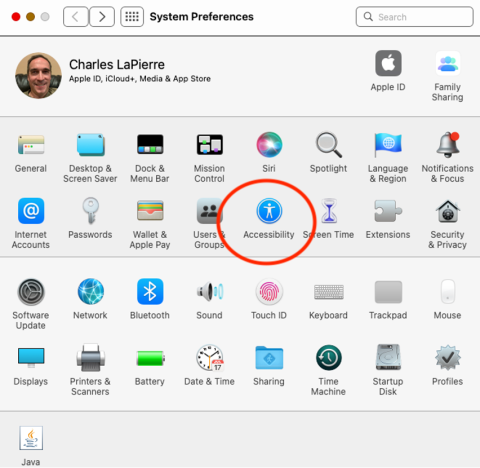
Selecting the Accessibility icon will open Accessibility Preferences. VoiceOver is in the left-hand panel.
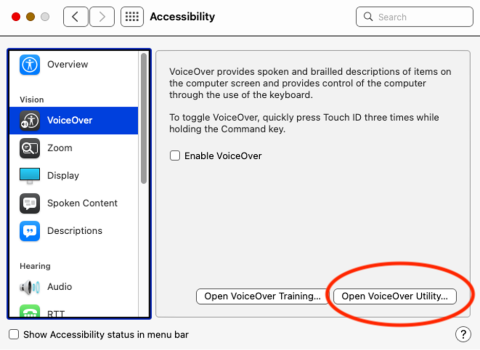
Select the Open VoiceOver Utility button. This will open the options for adjusting how VoiceOver will sound, the speed at which it speaks, which hot key controls it, etc.
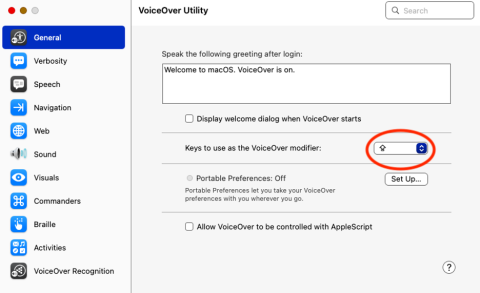
The General VoiceOver settings allow you to adjust the hot key sequence that controls VoiceOver (the VO Key, or VoiceOver Modifier Key). The options are Control + Option or Caps Lock. I prefer Caps Lock because it’s a single key, and with it down I can press other keys to have VoiceOver perform tasks. The screenshot above shows the Caps Lock key option circled in red.
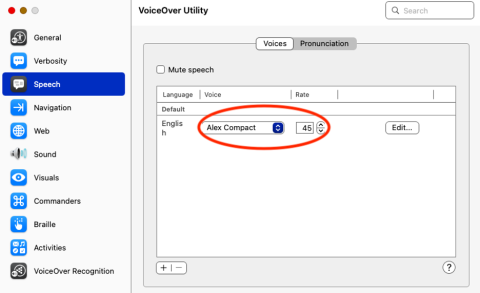
Adjust the speech rate if VoiceOver speaks too slow or too fast. You can adjust this by selecting the “Speech” option on the left-hand side as shown in Figure 4.
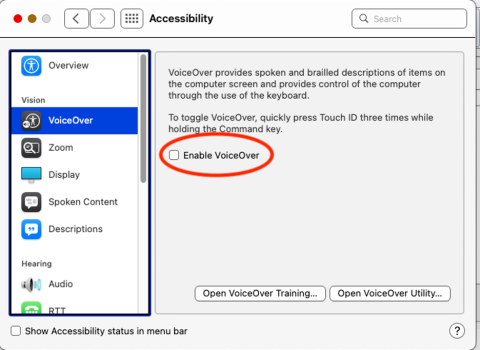
You can turn VoiceOver on or off in two ways: with the checkbox on the VoiceOver Settings page as described above, or by pressing the shortcut key combination (Command + F5).
To pause VoiceOver, press the VO hot key (Caps Lock or Control + Option) once. To resume, press it again.
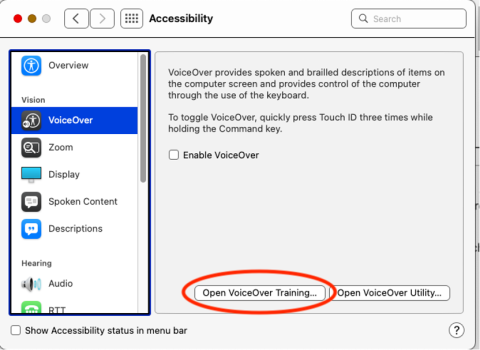
To learn how to use VoiceOver, select the Open VoiceOver Training button, as shown in Figure 6. This will open the tutorial.
Windows-Based
The Windows operating system has been the most popular with blind and visually impaired people for decades. Job Access with Speech (JAWS) has been the most used screen reader, and in the past few years Non-Visual Desktop Access (NVDA) has risen in popularity. NVDA is free, and that is one reason for this transition, but its quality has improved immensely. The Microsoft Accessibility Group is committed to keeping Windows the most accessible environment for people with any disabilities. They have made major improvements to Narrator, the built-in screen reader, so it now rivals the quality of JAWS and NVDA.
Narrator comes pre-installed in all recent versions of Windows, so we have focused on it in this training. If you have JAWS or NVDA, substitute one of them for Narrator.
Windows has many accessibility settings in their “Ease of Access Center,” including Narrator. To get to the Ease of Access Center, press the Windows key, which will take you to the Start menu search field. Type settings and press enter. From the list of options, select accessibility and press enter. Alternatively, you can press the shortcut key combination (Windows key +U) to get to the same location. Here are accessibility features for vision, hearing, and interactions.
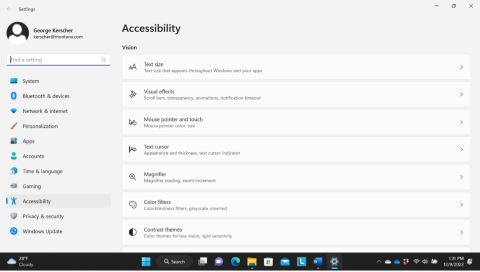
Under Vision, click on Narrator or, if you are not using a mouse, use the shortcut key combination (Windows key + U) followed by three presses of the tab key and then arrow down to Narrator and press enter. This will take you to the Narrator settings page.
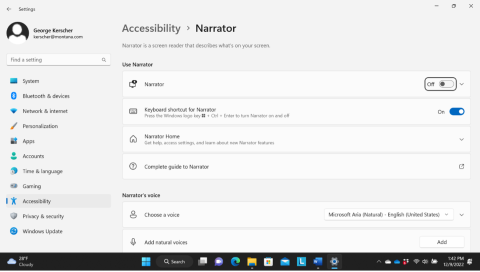
From the Narrator initial screen, where it says Use Narrator, press the spacebar to start it. Most of the time, you will use the shortcut key combination to launch Narrator (Windows key + CTRL + Enter).
When Narrator starts, it will show the Home screen, where you set your preferences and access the QuickStart tutorial and the complete Narrator Guide.

Narrator will start using the default voice and settings. I suggest changing the voice, speed, and verbosity settings. Choose a voice you like. It’s a personal preference. Set the speed so it is comfortable. People with a lot of experience with TTS sometimes speed it up. Think of this as the hearing equivalent of speed reading. But if you are new to it, make it understandable for you. You can speed it up as you become accustomed to the voice. Verbosity here does not carry the usual definition of using more words than necessary. In AT, it is a technical term derived from verbose mode in computing. It determines the level of detail about controls and characteristics of the text, such as the font, that Narrator reads to you along with the text itself. Try starting with level 2: Some control details, or the amount the amount of information can be overwhelming.
To pause or turn off Narrator, press the CTRL key; you will use it a lot!
Beginning with Windows 11 version 2022 H2, Narrator has “natural” voices. These usher in a new generation of Text-To-Speech (TTS) that will change people’s opinions of the quality of TTS compared with human speech.
Which version of Windows are you running?
To see which version of Windows you have, hit the windows key, type “winver” and press enter. This will display the version.
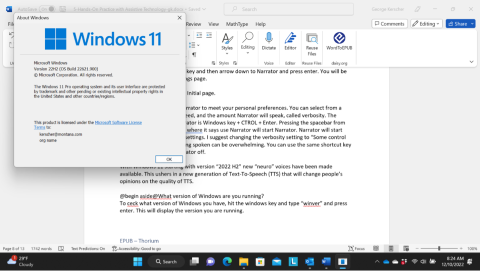
To see if a new version of Windows is available for your computer, hit the Windows key and type “check for updates”. This will open settings. Select check for updates and press enter. You must log in as an administrator to update your computer.
Selecting a Voice
Once Narrator starts, you will be on the Narrator Home screen. From here, click on settings or use the shortcut key combination (ALT + S) to open them. Then tab to or click on Home Group and expand those settings. Now the Voice Selection item is available. Click or tab to Voice selection and Press enter. You are now in the voice selection dialog.
The first time you start Narrator, it will use the default voice. Press enter and then tab to settings and press enter again. Press (shift + tab) to arrow up and down to hear the different voices. If you are running Windows 11 2022 H2 or later, you can add natural voices, which I highly recommend. Once you select a voice, you can tab to the rate, pitch, and volume controls. You will hear the changes as you adjust them. For the other settings, you can accept the defaults. Next, adjust the verbosity settings and select “Some control details” as described above.
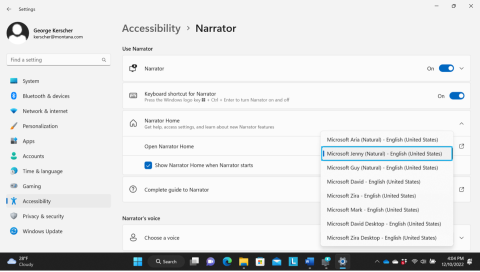
There are also settings for using Narrator with a touch screen or refreshable braille device and other possibilities. You can now close the Narrator settings window with the shortcut key combination (Alt + F4) and return to the Narrator Home screen.
QuickStart (tutorial)
The QuickStart tutorial is the first button on the Narrator Home screen. You can click on it, tab to it, or press the shortcut key combination (Alt + Q) to launch the tutorial.
We recommend the QuickStart tutorial to learn the basics of Narrator. For fun, you might turn down the brightness on your monitor or put something in front of the screen and use only the TTS audio output to control the tutorial. The mouse is disabled while running the tutorial, so you will have to use keyboard commands to control the computer. Have fun. This will help you understand the experience of blind and visually impaired patrons using technology.
Remember these important points: The caps-lock key, also called the “Narrator Key,” and the insert key are the default keys for controlling the modes of Narrator. The “scan” mode is for reviewing and reading text. To interact with an application, such as when you typing in an editable field, scan mode must be off. Narrator will automatically switch between the modes, but it may make mistakes, so be aware which mode you are in.
For detailed instructions on all aspects of Narrator, consult the Complete Guide, which is available from the initial screen. We have also included a link to it in the References section at the end of this chapter.
Thorium EPUB Reader
Thorium supports Mac, Windows, and LINUX. All versions share the same code base and are similar to use. We will walk through Thorium on the Mac, but the Windows experience is almost identical. We noted the few differences in the section on Windows, below.
In the Getting Started Chapter on Mac and Windows, you read instructions on how to download and install Thorium Reader on your Mac or Windows machine. Get familiar with it without any assistive technology, so you learn the basics of opening and reading an EPUB, how to bring up the Table of Contents, jump to a Chapter and read that chapter, and how to turn the pages within a book. DAISY provides excellent tutorials in the Thorium Reader Getting Started Guide. It contains useful hot keys and instructional videos.
Once you are comfortable using Thorium, the next step is to use it with a screen reader to experience how a blind person can read a book using it.
First, turn on VoiceOver. Next, open a book with Thorium. Use the VO+A key combination to begin reading. Thorium requires you to turn the pages yourself. When you reach the end of the page, Read to end of Page should highlight the next page button (>) which you can press with the VO + Space hot key. You can also tab to this button to skip to the next page without reading the entire page you are on.
Another way to read the page is to jump by paragraphs using the VO + Left/Right arrow keys to bounce around. Although not covered here there are several other ways to navigate documents including by headings, links, and tables.
You may hear VoiceOver say “underscore, underscore.” This indicates a hidden link for AT users. These links are used when skipping from one part of a document to another because there may be a disconnect between the visual location and where a screen reader might go. For example, if you activate a link to jump to a figure on a different page, the image may be visible on the page to a sighted reader, but the screen reader’s position may be at the top of the page. Activating the hidden link will jump the screen reader to the figure you want.
Another way to read using Thorium without having to turn on a screen reader would be to use the built-in “Read Aloud” function.
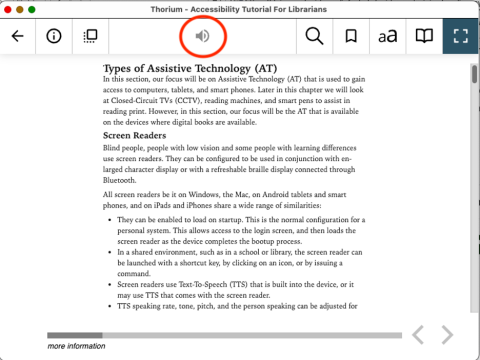
If you click on the Speaker icon at the top of the page as shown in Figure 13, Thorium will read the page using the built-in text to speech application while highlighting the text as it reads. This can help people who are learning to read or learning English. It also provides an easy way to have the book read aloud without learning to use a screen reader like VoiceOver.
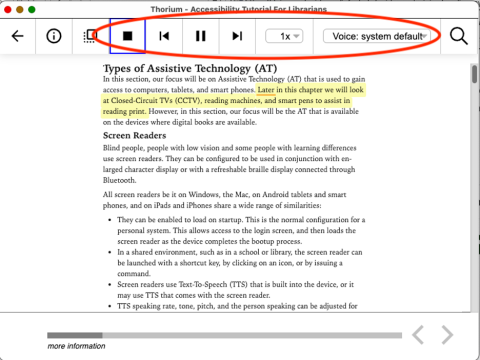
Speech controls appear in place of the speech icon button as shown in Figure 13. Use these to skip around, pause, stop speech, or change the speech rate, or change the voice used. These are adjustable during playback.
Windows and Narrator Considerations
Using Thorium on Windows with a screen reader works better in scroll view instead of page view. With scroll view enabled, you can read continuously to the end of a chapter. To select scroll view, press the shortcut key combination (CTRL + S) to open the settings.
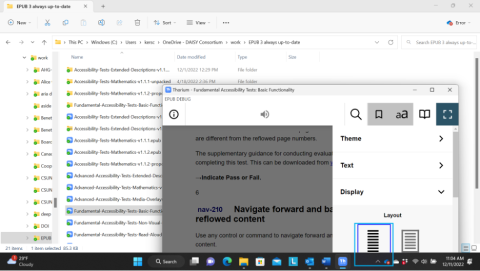
The settings for reading will appear. Select scroll. Make sure you save the settings before you leave.
Thorium has a comprehensive set of shortcut key combinations. You reach these through the bookshelf view. In bookshelf view select settings and scroll down to see them. You can edit them to suit your personal preferences. The option to save your settings is in the configuration item.
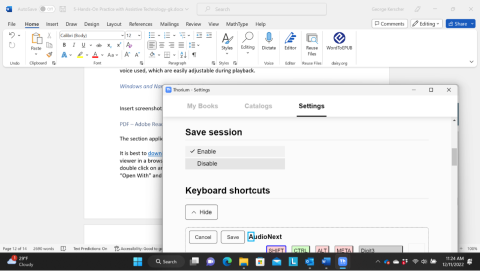
PDF—Adobe Reader
The section applies to both Windows and Mac.
If your computer does not already have Adobe Acrobat Reader, download and install it. It is more accessible than the PDF viewer built in to browsers. If Adobe Acrobat Reader is your default PDF viewer, double click on any PDF to open it. If not, you will need to right click the PDF, select “Open With,” and select “Adobe Acrobat Reader”.
When you open the PDF, you may see this pop-up:
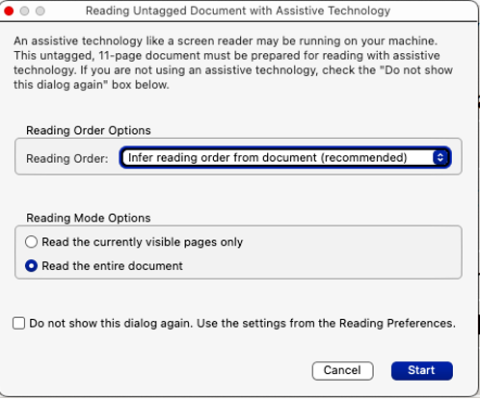
This means a screen reader probably cannot make sense of the PDF. If the PDF contains only images, the screen reader will not have any information to work with. If it contains text, the screen reader may voice it, but will not be able to describe images, there won’t be any heading information, paragraphs and lists may be out of order, and tables may not read correctly.
Using the same hot keys in Voice Over one can move around the document with the VO plus Up/Down/Left/Right keys, VO + A should start reading the document.
PDF and Narrator Considerations
The three screen readers for Windows (JAWS, NVDA, and Narrator) all struggle with PDF documents. As described above, if the PDF is not properly tagged, the screen reader will struggle with the document. If Adobe Reader is used with Narrator, the tab key will allow the user to fill in each form field. Scan mode must be off. However, the surrounding text will not be read. One could use Microsoft Edge to read the whole document, but forms cannot be filled in while using Edge.
At this time, JAWS and NVDA work better with Adobe Reader, however, the screen reader may struggle with filling out forms.
Mobile
Smartphones and tablets come with a wealth of accessibility features that are useful to people with vision, physical and motor, hearing, and learning differences. Use the links below to learn how users can customize their devices to meet their needs.
Apple provides extensive guides to the accessibility features for both the iPhone and iPad.
Android smartphones and tablets are available from a variety of manufacturers, but they all come with a standard set of visual, audio, and mobility features that improve accessibility.
Summary
VoiceOver on the Mac and Narrator on Windows come pre-installed as part of the operating systems. They provide an audio-based interface using TTS voices. To launch VoiceOver on the Mac, press the shortcut key combination (Command + F5). To turn on Narrator on Windows machines, use the shortcut key combination (CTRL + Windows + Enter). These same shortcuts will turn off the screen reader. JAWS and NVDA are also available for Windows computers, but they must be installed. Mobile phones and tablets also have built-in screen readers. On iPhones and iPads, the screen reader is VoiceOver. On Android phones and tablets it is Talkback. Thorium Reader for Windows, Mac, and LINUX, provides an outstanding reading experience with EPUBs. Thorium also provides a read aloud function with highlighting, which can provide a great experience for persons with dyslexia and other learning differences. The mobile platforms have many EPUB Reading Systems available. Reading PDF documents is possible, but there are many issues.
Conclusion
The screen readers built into the operating systems of computers and phones are powerful and provide to end users many opportunities that have not been available before. Screen readers provide an audio-based interface to the platforms. The screen readers are also compatible with refreshable braille devices. There are many voices, speaking rates, and other features that can personalize the experience. It takes time to learn these interfaces. Librarians should become familiar with screen readers so they can guide patrons to appropriate resources. Also, when a patron is using screen reader technology, the librarian should be able to recommend resources that are compatible with the technology.